| Ford East-Series | |
|---|---|
 Ford E-Serial Wagon | |
| Overview | |
| Manufacturer | Ford |
| Production | 1960–present (chassis only since 2015) |
| Model years | 1961–present (chassis only since 2015) 1961-2014 (van) |
| Assembly |
|
| Torso and chassis | |
| Grade | Full-size van |
| Chronology | |
| Predecessor | Ford F-serial console truck |
| Successor | Ford Transit (for U.s., Canada, Mexico and the Philippines[two]) |
The Ford Due east-Series, marketed also as the Ford Econoline and Ford Society Wagon, is a range of total-size vans manufactured and marketed by the Ford Motor Company. Introduced for model year 1961 as the replacement for the Ford F-Series panel van, the Due east-Series line is currently in its fourth generation.
Produced in multiple design variations for both retail and commercial sale, the East-Series was developed as a van for either cargo or passenger use, and equally a cutaway van chassis and stripped chassis (a chassis without bodywork). Since the 2015 model year, only the latter two designs are offered, as Ford replaced East-Serial vans with the Ford Transit. From 1980 to 2014, the E-Serial van was the all-time-selling full-sized van in the United States.[3]
The model line entered its 60th year of production for 2021, second only to the Ford F-Serial (in production since 1948) within Ford Motor Company in terms of longevity. The E-Series is assembled by Ford at its Ohio Assembly facility at Avon Lake, Ohio, which has produced the model line since 1975. Prior to its closure, Lorain Assembly in Lorain, Ohio, assembled the model line from 1961 to 2005.
First generation (1961–1967) [edit]
| Beginning generation | |
|---|---|
 1961–1967 Ford Econoline (customized) | |
| Overview | |
| Besides chosen | Ford Falcon/Econoline Station Bus Ford Falcon Club Wagon Mercury Econoline (Canada) |
| Production | 1960–1967 |
| Body and chassis | |
| Torso manner | 4-door panel van 6-door van eight-door van 2-door pickup truck |
| Layout | FMR layout |
| Related | Ford Falcon |
| Powertrain | |
| Engine | 144 cu in (2.4 50) Falcon Six I6 170 cu in (ii.8 L) Thriftpower Six I6 240 cu in (3.9 50) Truck Six I6 |
| Transmission | 3-speed transmission 4-speed manual iii-speed C4 automatic[iv] |
| Dimensions | |
| Wheelbase | ninety.0 in (2,286.0 mm)[5] |
| Length | 168.3 in (4,274.8 mm) 186.3 in (4,732.0 mm) (Econoline Super Van) |
| Width | 75.0 in (one,905.0 mm)[five] |
| Pinnacle | 76.9 in (i,953.iii mm)[v] |
Ford released the offset-generation Ford Econoline on September 21, 1960, for the 1961 model year.[iii] Kickoff development in 1957,[three] the model line served equally a replacement for the Ford F-Series panel delivery (and the smaller Ford Courier sedan delivery). Iii models were available, a cargo van, a rider van (also sold under the Station Motorcoach and Gild Wagon names), and a forward-control pickup truck.[6]
Competing directly confronting the rear-engined Chevrolet Corvair van and Volkswagen Transporter, the Ford Econoline established multiple design precedents adopted by successive American vans, including the Chevrolet Van and Dodge A100. While also a frontwards-command vehicle, Ford introduced a midengined configuration.[7] To amend cargo access past creating a flat load floor and enlarging the rear doors, the engine was placed between the front seats.
Chassis [edit]
The beginning-generation Ford Econoline was based on the Ford Falcon meaty car range.[vi] To accommodate its 90-inch wheelbase (the shortest for a Ford since 1908), the Econoline adopted a midengined configuration, placing the engine backside the front axle; consequently, the layout precluded the use of a V8 engine.
The Econoline was initially powered past the 85 hp (63 kW) 144-cubic-inch inline-6 (the standard engine of the Falcon); a 101 hp (75 kW) 170-cubic-inch inline-six was introduced equally an pick. For 1965, the 170 six became standard, with a 240 cubic-inch six introduced as an option. A three-speed manual was standard, with a Dagenham four-speed transmission introduced for 1963 and discontinued in 1964; the 170-cubic-inch engine was offered with a iii-speed automatic in 1964, and the larger two engines were both offered with a three-speed automatic every bit an pick thereafter.[viii]
In contrast to the Falcon, the Econoline was fitted with a solid front axle and a solid rear beam suspension with leaf springs for all four wheels.[9]
Body [edit]
In its torso design, the Ford Econoline adjusted several elements of the Volkswagen Type 2, while making major departures with other design features to adapt its midengined layout. In line with Volkswagen, the Econoline positioned the front seats above the front axle, making it a cabover-mode configuration (like to the Jeep Forward Control). The grille placed below the headlights was a blueprint feature borrowed loosely from the Ford Thames 400E (a predecessor of the Ford Transit).
The midengined placement enlarged the cargo area, equally the engine compartment was located frontward of the flat load flooring. While Volkswagen marketed rear-engined vans in the United States until 1991, Chevrolet/GMC and Dodge both adopted the design of the Econoline, introducing midengined vans for the 1964 model year.
Through its production, the showtime-generation Ford Econoline was offered in several variants. Aslope the standard six-door cargo van, an 8-door version (adding two doors on the driver side) was added for 1963. For 1964, a console van was introduced, deleting side loading doors altogether. For 1965, a "Super Van" extended-length torso was introduced, extending the trunk 18 inches behind the rear beam. Econoline cargo vans (except panel vans) were offered with or without side windows in several configurations.
-
1963 Ford Falcon Club Wagon
-
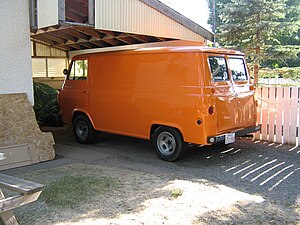
1961-1967 Ford Econoline cargo van (aftermarket wheels)
-
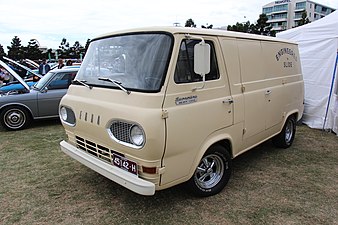
1964 Ford Econoline Heavy Duty cargo van (8-door version)
-

Ford Econoline TravelWagon (camper interior)
-
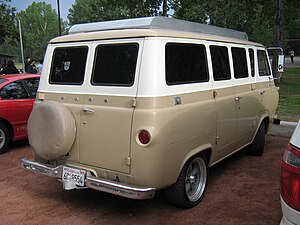
Ford Econoline TravelWagon (camper interior)
-

1965-1967 Ford Econoline Super Van (extended-length); aftermarket wheels
Variants [edit]
Alongside the Ford Falcon, the Ford Econoline was expanded into a product line including several vehicles. In Canada, the Econoline was marketed through both the sales networks of both Ford and Lincoln-Mercury (every bit a Mercury), to increase its presence outside of urban areas.
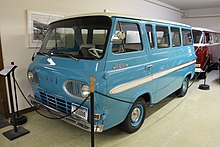
1963 Ford Falcon Society Wagon (passenger van)
Passenger van [edit]
Introduced alongside the cargo van in 1961, Ford introduced two rider variants of the Econoline (branded as part of the Falcon range). Alongside the Station Jitney (branded as both a Falcon and Econoline), Ford marketed the Lodge Wagon. While the Station Passenger vehicle was largely intended for commercial/armada utilize, the Club Wagon was marketed as an culling to station wagons.[ten] A 5-seat configuration was standard, with an eight-seat configuration offered as an option.
Pickup truck [edit]

1967 Ford Econoline Heavy Duty pickup truck
Introduced every bit a bodystyle for 1961, the Ford Econoline pickup truck derived its body from the cargo van. Like in configuration to the Chevrolet Corvair pickup, the Econoline pickup bed had no engine intrusion related to the engine compartment. While far shorter than the similar-GVWR F-100, the Econoline pickup was designed with a 7-foot-long pickup bed (sized between the ii F-Series offerings). 2 versions of the cab were offered, a standard "three-window" cab and an optional "5-window", which added wraparound windows to the cab corners.
The introduction of the 240-cubic-inch engine for 1965 necessitated a larger engine compartment, intruding slightly into the cargo bed (to provide clearance for the transmission bellhousing). The aforementioned year, a "Spring Special" package was offered as a trim selection.
At the time of its launch, Ford projected the Econoline pickup truck to outsell the van, but buyers reversed the trend, with the van outselling the pickup truck 9-to-one.[xi] The bodystyle ended production after the 1967 model year, remaining unique to the first generation.
Mercury Econoline [edit]

1964 Mercury Econoline pickup truck
The first-generation Econoline was sold by Ford of Canada past both Ford and Lincoln-Mercury. When branding its truck offerings under the Mercury brand, Ford of Canada maximized its presence in rural expanse serviced past either Ford or Lincoln-Mercury (but non both). Every bit with the Mercury M-series trucks, the Mercury Econoline was largely identical to its Ford namesake (differing primarily in badging); the model was marketed in Canada as a cargo and passenger van and a pickup truck.
For 1961, Ford of Canada began production Mercury-brand Econolines at Oakville Assembly in Ontario; later that year, Mercury Econoline pickup was shifted to Lorain Assembly in Ohio.[12] For 1962, production of the unabridged model line returned to Oakville. After 1965, product of the model line was sourced from the Usa.[12]
Production numbers of Mercury Econolines were low; for example, 1,291 Mercury Econoline pickup trucks were built in 1965.[thirteen] Following the 1968 model year, Ford of Canada concluded the sale of Mercury-branded trucks, leaving the Mercury Econoline as the terminal Mercury-branded van until the 1993 Mercury Villager minivan.
2d generation (1968–1974) [edit]
| | This section needs expansion. You can aid by calculation to it. (December 2011) |
| Second generation | |
|---|---|
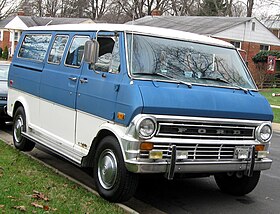 1972–1974 Ford Lodge Wagon | |
| Overview | |
| Production | 1968–1974 |
| Body and chassis | |
| Body style | three-door van |
| Layout | FR layout |
| Powertrain | |
| Engine | 240 cu in (3.9 Fifty) I6 300 cu in (4.9 L) I6 302 cu in (iv.9 L) Windsor V8 |
| Transmission | 3-Speed Manual 3-speed Cruise-O-Matic automated |
| Dimensions | |
| Wheelbase | SWB: 105.5 in (two,679.7 mm) LWB: 123.5 in (3,136.9 mm) |
Following a lengthy United Automobile Workers strike in 1967, the launch of the second-generation Econoline van was delayed nigh iv months, until January 1968. Instead of marketing the van as a 1968 or 1968-1/2 model, Ford marketed it for model year 1969. Losing its Falcon roots, the second-generation Econoline became a heavier-duty vehicle, sharing many of its underpinnings with the F-serial full-sized pickups.
Chassis [edit]
The unibody construction of the previous generation was carried over, and the mid-engine, forward-control layout gave way to a front end-engine layout with a forrard axle placement; this allowed employ of the "Twin I-Beam" front suspension from the F-series trucks. The wheelbase increased 15 in (381.0 mm), while the xviii in (457.ii mm) longer long-wheelbase model became the largest full-sized van offered in North America at the time.
Following Dodge and Chevrolet/GMC, a V8 engine became optional.
Torso [edit]
With the alter of chassis and axle configurations, the Econoline gained a conventional hood for engine access, though engine access remained largely from the van's interior. The redesign provided a conventional grille, styled similarly to the F series.
For 1971, the grille was redesigned to lucifer the updated F series. For 1972, a sliding rear door became an selection; introduced on a cutaway van chassis was the Hello-Cube van, a cab-chassis version of the Econoline with a box-van body. The introduction of the cab-chassis variant became popular in the recreational-vehicle industry (a Class C RV), a segment yet dominated past the Due east series in the 2010s.
Interior [edit]
Inside of the Econoline, the shift of the engine location moved the engine housing from between the seats to in forepart of the driver and front passenger, under the windshield. While the Econoline cargo van remained, it was joined past an Econoline rider van (replacing the Falcon van). To attract more buyers to passenger vans, Ford introduced two new trims of the passenger van, the Ford Society Railroad vehicle and Ford Club Wagon Chateau. Based on the long-wheelbase version, the Chateau had air conditioning, houndstooth fabric on all seats, an AM/FM sound system, and the option of 12-passenger seating.
- 2nd-generation models 1969–1974
-

1969-71 Econoline Window Van
-

1972 Econoline motorhome conversion
-
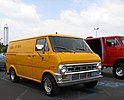
1973 Econoline 100
-

1974 Ford Econoline Eastward-300 Quadravan
3rd generation (1975–1991) [edit]
| Third generation | |
|---|---|
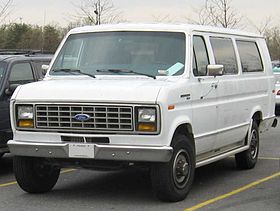 1983–1991 Society Wagon | |
| Overview | |
| Likewise chosen | Ford Club Wagon |
| Production | 1975–1991 |
| Body and chassis | |
| Body manner | 3-door van |
| Layout | FR layout |
| Platform | Ford VN platform |
| Related | Ford Carousel |
| Powertrain | |
| Engine | 300 cu in (iv.9 L) I6 302 cu in (4.9 L) Windsor V8 351 cu in (5.eight L) Windsor V8 460 cu in (7.5 L) 385 V8 half dozen.9 Fifty Navistar diesel V8 7.3 Fifty Navistar diesel V8 |
| Transmission | 3-speed manual iv-speed manual 3-speed automatic 4-speed automated 5-speed transmission |
For 1975, the Econoline/Club Wagon were given a complete redesign. Based on an all-new chassis, Ford became the commencement American manufacturer to accommodate body-on-frame construction to a full-size van.
The new-generation Econoline would get common not just in its own right, but as the basis for other vehicles. With a full frame, the Econoline became popular equally a cutaway van chassis; the design served equally a basis for many ambulances, and various types of trucks and buses. The shared drivetrain with the F-Serial marked the showtime of aftermarket iv-wheel bulldoze conversions. During the 1970s, the Econoline became popular as a basis for van conversions. Using the sparsely-equipped Econoline cargo van as a basis, a luxurious interior was fitted, along with all-encompassing customization of the exterior.
The 1978 Ford Econoline was MotorTrend's beginning-e'er Truck of the Year.
Chassis [edit]
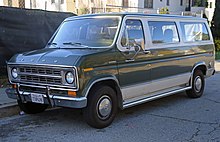
1975–1978 Ford Econoline 150 Chateau

1988 Econoline 350 cutaway van

1980s Ford Club Wagon XLT
To increase the versatility of the full-size van line, the Econoline was adult using torso-on-frame construction for the offset time. In addition to increasing the strength of the chassis, the configuration allowed more than commonality with the F-series trucks. As before, the Twin I-Beam front suspension was used. In its new configuration, the engine was moved further forward and lowered relative to the body. The van grew in size: the 124 inches (three,150 mm) short-wheelbase configuration was a half inch longer than the previous long-wheelbase chassis; the new long-wheelbase chassis was 138 inches (three,510 mm), the longest wheelbase full-size van sold until 1990. Later on the 1984 model year, the 124-inch wheelbase Club Wagon passenger van was discontinued, and the 124-inch wheelbase Econoline Cargo Van was discontinued after the 1990 model yr, leaving the 138-inch wheelbase as the sole choice.
In 1982, to increase the fuel economic system of the Econoline without a major loss in engine output, Ford introduced the option of a 6.nine L IDI diesel V8 produced by International Harvester; in 1988, this was enlarged to 7.iii L. The diesel fuel V8 engines were available but in Econoline 350s (or Club Wagons sold on the same chassis). The cutaway version was available with the larger (5.8 or 7.5 L) gasoline V8s or the diesel V8.[14]
Due to the popularity of automated transmissions in full-size vans, Ford discontinued all transmission transmissions after the 1989 model yr. The column-shifted 3-speed departed later on 1986, leaving the floor-shifted 4-speed overdrive manual as standard. The four-speed was replaced by a Mazda-sourced v-speed M5OD for 1988.
Body [edit]
Dissimilar its predecessors, Ford designed the 1975 Econoline with a "two-box" layout. Similar to the Ford Transit of the fourth dimension, the configuration moved the engine as far frontwards as possible and lower in the chassis than in its predecessor; although the hood was well-nigh twice every bit long, the hoodline was much lower. A higher degree of parts commonality with the F serial made itself known in the bodystyling: the vent windows, taillights, bumpers, and wheels were common items between the two vehicles.
During its sixteen-yr production run, the outside of the Econoline/Club Railroad vehicle would remain nigh unaltered. In 1978, the Super Van/Super Wagon was introduced; based on the 138-inch wheelbase, it was a rear trunk extension assuasive for extra cargo room or an extra row of seating (for upward to 15 passengers). In 1979, a modest facelift updated the grille design; circular headlights were replaced past rectangular units. In 1983, the Ford Bluish Oval was added to the grille, replacing the "FORD" lettering on the hood.
Although the 1986 Ford Aerostar minivan would introduce styling far unlike from the Econoline, the basic styling of the full-size van would heavily influence the Ford Ranger (and its SUV offspring, the Ford Bronco 2).
Interior [edit]
Inside, the redesign of the chassis expanded interior room, though the rear of the engine still remained between the front end seats; an engine comprehend still provided access for servicing. Sharing many controls with the F series, the new design also improved interior ergonomics. In three body sizes, the Econoline was produced in a cargo van and passenger van, with the latter produced in three trim levels; base, Custom and Chateau. In addition, the Guild Wagon was produced solely as a passenger van. After 1980, this was replaced by F-series nomenclature of XL and XLT. In line with the F-Serial, the Econoline/Club Wagon was sold in 100/150/250/350 variants, with the Econoline 100 discontinued in 1983 (Gild Wagon chassis variants were non denoted).
| 124" WB | 138" WB (Standard Van) | 138" WB (Super Van) | |
|---|---|---|---|
| Length | 186.8 in (4,745 mm) | 206.8 in (5,253 mm) | 226.8 in (v,761 mm) |
| Wheelbase | 124 in (3,149.6 mm) | 138 in (3,505.2 mm) | |
| Height | 79.1–79.ix in (2,009.1–two,029.5 mm) | 79.ii–84.4 in (2,011.7–2,143.8 mm) | fourscore.ix–84.eight in (2,054.nine–2,153.9 mm) |
| Width | 79.9 in (2,029 mm) | ||
Fourth generation (1992–nowadays) [edit]
| Fourth generation | |
|---|---|
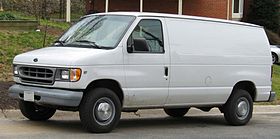 1997–2002 Ford Econoline | |
| Overview | |
| Also called | Ford Econoline Ford Guild Railroad vehicle Ford Econoline Wagon |
| Production | 1991–2014 (rider/cargo van) 1991–present (cutaway/stripped chassis) |
| Model years | 1992–2014 (rider/cargo van) 1992–nowadays (cutaway/stripped chassis) |
| Body and chassis | |
| Torso style | 3/iv-door van |
| Layout | FR layout |
| Platform | Ford VN platform |
| Powertrain | |
| Engine |
|
| Transmission |
|
| Dimensions | |
| Wheelbase | 138 in (iii,505 mm) |
| Length |
|
| Width | 79.3–79.9 in (two,014–2,029 mm) |
| Meridian | eighty.seven–84.one in (2,050–2,136 mm) |
| Curb weight | four,773 lb (2,165 kg) |
| Chronology | |
| Successor | Ford Transit |
For the 1992 model year, Ford introduced the fourth generation of the Econoline/Club Carriage. While the tertiary-generation chassis was largely carried over, the trunk and interior underwent a complete redesign. The vehicle has received several revisions during its production, with the most recent taking place in 2021.
Toward the terminate of the 1990s, Ford began to phase out the use of the Econoline and Club Carriage nameplates. For 1999, the Club Railroad vehicle nameplate was discontinued (in favor of Econoline Carriage). After the 2000 model year, the Econoline was renamed the E-Serial, a nomenclature closer to that of Ford's full-size F-Series trucks.
In June 2014, production of E-Series passenger and cargo vans was discontinued equally sales of the Ford Transit began in North America. From the 2015 model year onward, the Due east-Series has remained in product solely in cutaway and stripped chassis configurations.[xvi]
Chassis specifications [edit]
The quaternary-generation shares the VN platform of the third-generation Econoline, introduced in 1975. Sharing many components with F-Serial trucks, the E-Series retained the "Twin I-Beam" front suspension used past rear-wheel drive Ford trucks in North America from the 1960s to the early on 1990s. The rear interruption was a live rear axle with rear foliage springs.
For the 2008 model yr, the chassis underwent its largest revisions of the quaternary generation. In an effort to meliorate handling and safe, larger brakes were added, improved steering, rollover stability control, and a higher GVWR.[17] The twin I-axle layout was retained, making it the second last Ford vehicle to use it.[18]
Powertrain [edit]
At its 1992 launch, the fourth-generation carried over its powertrain line from the third-generation model line (sharing it with the 9th-generation F-Series). A 4.9L inline-six was standard, with a v.0L V8, a 5.8L V8 offered as options. On 250 or 350-series vans, a vii.5L V8 and seven.3L Navistar diesel V8 were also optional; the diesel became turbocharged in 1993. During 1994, the IDI diesel was replaced by a seven.3L Ford Powerstroke diesel V8 (also sourced from Navistar).
For 1997, the Due east-Series underwent a revision of its engine lineup, retaining only the seven.3L diesel fuel. Sharing its gasoline engines with the tenth-generation F-Series, a 4.2L V6 replaced the inline-6 and a vi.8L V10 replaced the seven.5L V8. The 5.0L V8 and the v.8L V8 were replaced by 4.6L and 5.4L V8s, respectively.
For 2003, the vii.3L diesel was replaced by a 6.0L diesel from Navistar. While gaining an intercooler over its predecessor, due to the lack of airflow in the engine compartment (compared to Super Duty trucks), Ford had to detune the Eastward-Serial version of the 6.0L V8. For 2004, the 4.2L V6 was dropped and the 4.6L V8 became the standard engine, making the East-Serial the first American full-size van with a V8 engine standard.
The vi.0L Power Stroke was offered until 2009 in the Ford Econoline vans (model year 2010), even though Ford Super Duty trucks were upgraded to the 6.four version in 2007. Diesels were no longer offered after the 2010 model year. For 2009, the Eastward-Series gained flexible-fuel adequacy with 4.6L and v.4L engines (allowing them to use E85).
In May 2014, the concluding 4.6L V8 was produced for the E-Serial, with the five.4L V8 becoming the standard engine for 2015. For 2017, the 6.8L V10 replaced the 5.4L V8 as the standard engine, with a vi.2L V8 becoming the optional engine; along with flex-fuel capability, both engines were offered with options for conversion to CNG or LPG/propane.[nineteen]
For its 2021 model year revision, the E-Series adopts the 7.3L V8 of the Super Duty truck equally the simply engine option, offered with an option for conversion to CNG or LPG/propane.[20]
| Engine | Configuration | Production | Fuel type | Transmission |
|---|---|---|---|---|
| Ford Truck Six | 4.9 L (300 cu in) OHV I6 | 1992–1996 | Gasoline |
|
| Ford Windsor V8 | iv.9 L (302 cu in) OHV V8 | 1992–1996 | ||
| 5.eight 50 (351 cu in) OHV V8 | 1992–1996 | |||
| Ford 385 V8 | 7.5 L (460 cu in) OHV V8 | 1992–1996 | ||
| Navistar IDI V8 | 7.3 L (444 cu in) OHV V8 | 1992 | Diesel fuel | |
| 7.iii L (444 cu in) OHV V8 turbocharged | 1993 | |||
| Navistar T444E V8 (Ford Power Stroke) | vii.3 L (444 cu in) OHV V8 turbocharged | 1994–2003 | ||
| Navistar VT365 V8 (Ford Power Stroke) | 6.0 L (365 cu in) OHV 4V V8 turbocharged | 2004–2010 | ||
| Ford Essex V6 | iv.2 L (256 cu in) OHV V6 | 1997–2003 | Gasoline | |
| Ford Triton V8 | 4.6 L (281 cu in) SOHC 2V V8 | 1997–2014 |
| |
| 5.4 Fifty (330 cu in) SOHC 2V V8 | 1997–2016 | |||
| Ford Triton V10 | vi.8 Fifty (413 cu in) SOHC 2V V10 | 1997–2019 |
| |
| Ford Boss V8 | half dozen.2 L (379 cu in) SOHC 2V V8 | 2017–2020 | ||
| Ford Godzilla V8 | 7.iii L (445 cu in) OHV 2V V8 | 2021–present |
| 6-speed automatic (TorqShift) |
Body [edit]
During its production, the torso manner of the quaternary-generation E-Series underwent minor revisions in 1997 and 2003, with a major revision in 2008.
In line with the F-Series, the Econoline/E-Series was sold in 150, 250, and 350 serial, denoting ½, ¾, and i-ton chassis (the Club Wagon was not designated by chassis size).
The torso was available in 2 lengths, with the extended-length version exclusive to the 250 (3/4-ton) and 350-series (1-ton) chassis for both cargo and rider vans. The cargo van was sold every bit a two-passenger vehicle, with the passenger van sold in various configurations, including v, eight, 9, 12, and 15 passengers.
Trim [edit]
During its product, the fourth-generation model line underwent several name changes. As with the previous generation, the Econoline was sold as both a cargo van and as a rider van (Econoline Wagon) with the Ford Club Wagon sold only every bit a passenger van. For 1992 the luxury-oriented Chateau trim line of the Club Wagon, dormant since 1989, made a return, slotted to a higher place the XLT trim. For 1992, the Club Wagon Chateau was awarded Truck of the Year by Motor Tendency. For 2001, the Chateau was dropped, replaced by the East-150 Traveler; due to low sales, it was dropped after a single model year.
Model history [edit]
1992–1996 [edit]

1992–1994 Ford Club Wagon (fifteen-passenger)
For the 1992 model year, Ford introduced the fourth-generation of the Econoline/Club Railroad vehicle. While the third-generation chassis was largely carried over, the trunk and interior underwent a complete redesign. In contrast to its GM and Dodge competitors, the two-box body configuration made a return. To optimize the aerodynamics of the van body, the hood was angled slightly downward and the windshield was raked back (though far less than the Aerostar). If specified, all side and rear window glass was flush-mounted to the body, along with wraparound tail lamp lenses; flush-mounted composite headlamps were an option (standard on all Club Wagons). For 1992, the Econoline/Guild Wagon became the showtime total-size vans produced with a heart-mounted restriction light.
When redesigning the interior, the commuter compartment underwent all-encompassing modernization. While infinite between the front seats was again dominated by the front end-mounted engine, a redesign of the engine cover freed upwards additional passenger room. Sharing controls and components with the F-Serial and Aerostar, the model line became the start total-size van equipped with a standard commuter-side airbag (except for 350-series models, exempted by their GVWR). The musical instrument panel received more legible instruments (but no tachometer); a 6-digit LCD odometer replaced the previous 5-digit analog unit.
For 1994, Cfc-free R134a air conditioning refrigerant was adopted beginning with September 1993 production. For 1995, the taillamps were revised, removing the amber plow signals.
1997–2002 [edit]
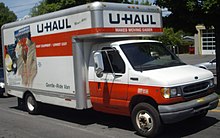
1997–2002 Ford E-350 cutaway chassis (outfitted every bit a U-Haul vehicle)
For 1997, the East-series underwent a revision of both its exterior and interior, largely to bring its appearance in line with other Ford trucks. The previous egg-crate grille was replaced by an eight-hole oval-shaped cutout (matching the Explorer and F-150).
The interior underwent a complete redesign, adopting an all-new dashboard. Following the adoption of dual airbags (for all versions), the "brick"-style steering wheel was replaced past ane with a center-mounted horn. To improve the convenience of interior controls, rotary switches for climate controls were introduced, along with a double-DIN radio. The instrument console was redesigned, reintroducing an analog odometer. The front seats underwent a redesign, relocating the seatbelt mounting to the B-pillars.
2003–2007 [edit]

2003–2007 Ford Eastward-350 extended-length cargo van
For 2003, the E-serial underwent an exterior update, adopting the grille introduced by the 2002 E-550 Super Duty (see below). The new grille shifted the Ford Bluish Oval emblem from the hood to the center of the grille (for the kickoff time since 1991); based on trim, the grille was either dark grey or chrome. The front turn indicate lenses were changed from articulate to amber (their offset alter since 1992).
Congruent with the exterior revision, the interior saw several updates. While the dashboard remained essentially unchanged, the engine cover was redesigned (including redesigned loving cup holders); the design now included a center-mounted glovebox (absent from the Due east-Series since 1974). For 2004, the instrument cluster was updated with a digital odometer; heavy-duty vans now offered a tachometer (as an option).
Ford Due east-550 Super Duty [edit]

Ford E-550 Super Duty (outfitted as mobile broadcasting vehicle)
For 2002, Ford introduced the Due east-550 Super Duty as the highest-GVWR version of the Eastward-Series.[21] Offered solely in a cutaway-cab pattern,[21] the E-550 was intended to bridge the gap betwixt the pickup truck-derived F-450/550 Super Duty and the F-650 medium-duty trucks.
Sharing a number of chassis components with the F-550 Super Duty, the E-550 was distinguished by a grille styled in line with Super Duty pickup trucks (with a 3 horizontal slots betwixt two vertical openings). To accommodate the wider, heavier-duty forepart axle, the van body was fitted with a larger front bumper and plastic fender flares (shared with the F-550 truck). Several wheelbases were offered, ranging between 159.five inches and 233.five inches; as with the Super Duty and the E-350/450, the E-550 was powered by either a 6.8L V10 or a 7.3L V8 turbodiesel.[21]
Following the 2003 model year, Ford ended product of the E-550.
2008–2014 [edit]

2008 Ford E-250 cargo van
In 2008, the E-Series received a restyled forepart blueprint similar to that of the newly introduced Ford Super Duty lineup of trucks. The interior design from the older model E-Serial was still used for the 2008 model year.
For the 2009 model twelvemonth, Ford introduced a new interior for the Eastward-Series. The instrument panel was now larger and easier to read, and included an enhanced bulletin center that could brandish warning messages, and other information, and the forepart interior door panels were redesigned with 'E SERIES' branding embossed into the panels. Radios were as well revised, with an auxiliary audio input jack being offered as standard equipment on all radios for the first time. The Ford Sync entertainment system, designed past Microsoft, and calculation USB integration and hands-free Bluetooth calling and wireless audio streaming capabilities was at present also offered as an option. Finally, an optional touchscreen GPS navigation organisation radio was likewise offered, and included Hard disk Radio on select models.
Starting with the 2011 model year, the six.0L Power Stroke turbo-diesel V8 engine was discontinued, and the East Series was no longer offered with a diesel engine.
2015-2020 [edit]

Dashboard, 2009–2015 Ford E-Series
For the 2015 model yr, Ford discontinued sales of the E-Series passenger and cargo vans, replacing them with the quaternary-generation Ford Transit.[22]
Because of its popularity with upfitters who convert the chassis into recreational vehicles, buses, or other specialized vehicles, Ford announced it would continue to offer the East-Serial as a cutaway chassis (open up cab, to exist fitted with second-party rear body), a chassis cab (enclosed cab, to exist fitted with second-party rear trunk) and a stripped chassis (no cab, to be fitted with a consummate second-party body).[23]
Ford said it made the alter, because while the East-Series had remained the acknowledged vehicle in the full-size van segment since 1980,[24] [25] the model line had seen niggling alter since 1992 on a chassis introduced for the 1975 model year. At the time of its 2008 update, 95% of sales were to commercial or fleet users, with almost half of production represented past cargo vans.[26] Sold exterior of North America since 1965, the Transit was introduced to the United States and Canada, offering increased fuel economy and additional body configurations over the Due east-Series.[22]
Product of the base 4.6L V8 Ford Modular engine was discontinued later the 2015 model year (at the time the E-Series was the last Ford product to use that engine). For the 2016 model year, the only engine option was the 6.8L V10 Triton engine. Starting in 2017, Ford began offering the 6.2L V8 Boss engine.
The chassis cab configuration was eliminated starting with the 2019 model year. Ford did non produce the E-Serial for the 2020 model yr.
2021 revision [edit]

2021 Ford E350 Cutaway; the looks remain unchanged
For the 2021 model twelvemonth, the E-Series interior underwent a major redesign, adopting a more than mod electronic instrument cluster with steering wheel controls first adult for the Ford Super Duty.[20] Base of operations models at present have a 3.5-inch (89 mm) monochromatic screen with an available upgrade to a 7-inch (180 mm) colour screen. The new instrument console blueprint also allowed for the improver of new optional safe equipment that was previously non available on the E-Series, including adaptive cruise control, a forward standoff avoidance system, a lane departure warning system and automatic high-beam front headlamps.[27] Meanwhile, the only available mill sound system is a basic unmarried DIN model with AM/FM radio, Bluetooth for hands-free calling and wireless stereo audio streaming, and a USB input. Unlike previous models, there is no pick to equip the Ford Sync infotainment system.
Nether the hood, all E-Series models now utilise same 7.3L V8 Godzilla naturally-aspirated gasoline engine offered on the Ford Super Duty
The exterior design of the 2021 E-Series remains fiddling changed from the 2008 redesign.
Product and sales [edit]
| Model year | US production |
|---|---|
| 1961 | 61,135[28] |
| 1962 | 76,938[28] |
| 1963 | 88,053[28] |
| 1964 | 83,079[28] |
| 1965 | 76,867[28] |
| 1966 | 84,180[28] |
| 1967 | 81,752[28] |
| Calendar year | Us sales |
|---|---|
| 1997 | 186,690[29] |
| 1998 | 206,026[30] |
| 1999 | 202,024[31] |
| 2000 | 187,027 |
| 2001 | 159,565 |
| 2002 | 165,085[32] |
| 2003 | 161,721 |
| 2004 | 171,017[33] |
| 2005 | 179,543 |
| 2006 | 180,457 |
| 2007 | 168,722 |
| 2008 | 124,596 |
| 2009 | 85,735 |
| 2010 | 108,258 |
| 2011 | 116,874 |
| 2012 | 122,423 |
| 2013 | 125,356[34] |
| 2014 | 103,263[35] |
| 2015 | 50,788[36] |
| 2016 | 54,245[36] |
| 2017 | 53,304[37] |
| 2018 | 47,936[38] |
| 2019 | 45,063[39] |
| 2020 | 37,001 |
| 2021 | 37,122 |
| 1997-2021 sales | 3,079,841 |
Platforms [edit]
The Ford VN platform is the Ford Motor Company code designation for vans designed in North America. The platform architecture was introduced in 1974, when Ford introduced the third generation of the Econoline full-size van. In the 1980s, the classification was used separately for the Ford Aerostar mid-size van, which is mechanically unrelated to the Econoline/Club Carriage/E-Serial. Since 2014, the architecture has no longer been used for mass-produced passenger vehicles, with all examples at present produced every bit chassis cabs or blank chassis.[ citation needed ]
Both the VN and VN1 chassis utilize rear-bicycle drive layouts with longitudinally-mounted engines.
VN58/VN127 [edit]
Introduced in 1974, Ford introduced the 3rd-generation Econoline, the kickoff produced with a full-length frame. For 1992, the 4th-generation Econoline/Club Wagon/E-Series was introduced, marking a substantial revision to the chassis architecture and a completely new body. For 1997, Ford replaced the unabridged gasoline powertrain range, shifting from overhead-valve engines to overhead-cam engines.
Post-obit the introduction of the V363N Ford Transit, the VN E-Series ended product as a cargo/rider van after the 2014 model yr. From the 2015 model twelvemonth onward, the Due east-Series has remained in production as a cutaway-cab chassis (no bodywork aft of the forepart doors) and as a stripped chassis (with no bodywork).
This is the final chassis that uses the Ford "Twin I-Axle" front pause architecture.
Vehicles using this platform include:
- Ford Econoline/Club Wagon/E-Serial — full size vans (VN58, virtually 1989; VN127 1995)
- Ford Carousel — cancelled mid-size van based on SWB Econoline (planned for 1975–1976)[ commendation needed ]
VN1 [edit]
The VN1 platform is a platform that was developed by Ford for use for mid-size vans, specifically the Ford Aerostar. The get-go Ford vehicle to employ an alphanumeric platform designation, the VN1 platform architecture is mechanically unrelated to the E-Series van, sharing only its rear-cycle-bulldoze layout.[ citation needed ]
While using a dedicated chassis, the Aerostar was designed with a loftier degree of parts commonality with other Ford light-truck products of the time (initially, the Ford Ranger/Bronco Two and the afterward Ford Explorer/Mazda Navajo), sharing major components including the brakes, front suspension, wheels, and powertrain. One notable exception is the rear suspension layout; the coil-sprung live rear beam uses a three-link configuration, like to the Ford LTD Crown Victoria and Fox-trunk Mustang.
In dissimilarity to the E-Series van, the unibody chassis of the Aerostar was designed with additional full-length frame track; this construction was too used on the Chevrolet Astro/GMC Safari vans, the Jeep Cherokee XJ, and the Honda Ridgeline pickup truck.
Vehicles using this platform include:
- Ford Aerostar—mid-size van (1986-1997), code named VN1.[ commendation needed ]
See also [edit]
- Ford VN platform
References [edit]
- ^ "Plant Information: Oakville Assembly Complex". Media.ford.com. Archived from the original on June 14, 2010. Retrieved May 31, 2011.
- ^ "Ford PH goes big with 15-seater Transit, starts at PHP 2.iii million - Car News". 27 November 2019.
- ^ a b c Lee, Peter (2015). Ford Transit: L Years. Crowood. ISBN9781847978745 . Retrieved 29 February 2016.
- ^ "Econoline.org". Econoline.org. Retrieved Nov 23, 2020.
- ^ a b c "1963 Ford Falcon Van brochure". Oldcarbrochures.com. Retrieved February 6, 2014.
- ^ a b Statham, Steve (1995). Ford Pickup Trucks. Motorbooks. pp. 71–72. ISBN9780879389871 . Retrieved 29 February 2016.
- ^ Gunnell, John (2005-10-25). American cars of the 1960s. 2005. p. 212. ISBN9780896891319 . Retrieved 29 February 2016.
- ^ "Econoline Transmissions". econoline.org.
- ^ "Directory Index: FMC Trucks-Vans/1961_Trucks-Vans/1961_Ford_Econoline_Van_Brochure". www.oldcarbrochures.com . Retrieved 2018-04-17 .
- ^ "Directory Index: FMC Trucks-Vans/1963_Trucks-Vans/1963_Ford_Falcon_Van_Brochure". www.oldcarbrochures.com . Retrieved 2018-04-17 .
- ^ Ernst, Kurt (19 January 2014). "Hemmings Find of the Solar day – 1961 Ford Econolpne pickup". Hemmings. Archived from the original on 22 January 2014. Retrieved 29 February 2016.
- ^ a b Truesdell, Rich (November 3, 2014). "Mercury Trucks Dare to Be Different". Vintage truck magazine. Archived from the original on 12 November 2014. Retrieved 29 February 2016.
- ^ "1965 Mercury Econoline pickup truck for sale". American Dream Cars . Retrieved 29 February 2016.
- ^ Mele, Jim (July 1990). "The New Models for 1991: Mid-Range Trucks". Fleet Owner. Vol. 85, no. 7. FM Business Publications. p. 70.
- ^ "1980 Ford Econolpne Van". Oldcarbrochures.com. Retrieved February half-dozen, 2014.
- ^ Ramsey, Jonathon (April 18, 2014). "Ford Due east-series chassis cabs and cutaways to survive mass Transit onslaught". autoblog.com . Retrieved October 28, 2014.
- ^ "Ford Rolls Out Super Duty-Inspired 2008 Due east-Series Vans". Edmunds Within Line. March 9, 2007. Archived from the original on March 20, 2007.
- ^ "Ford's Twin I-Beam Front Interruption". www.hemmings.com . Retrieved 2019-03-07 .
- ^ "New ergonomic and tech options heighten 2017 Ford Transit lineup; new engine for Due east-series stripped chassis, cutaway". Ford Motor Company Media Center. March 1, 2016.
- ^ a b "New 2021 Ford Eastward-Series Chassis Cab Debuts". Ford Authority. 2019-03-05. Retrieved 2019-12-28 .
- ^ a b c "StackPath". www.fleetowner.com . Retrieved 2020-11-24 .
- ^ a b "Ford's Transit Van continues Eastward-Series' success". Detroit News.
- ^ "Ford Will Continue E-Series Cutaway/Stripped Chassis – PickupTrucks.com News". news.pickuptrucks.com . Retrieved 2016-06-22 .
- ^ "Cardinal Milestones in 50-Twelvemonth History of Ford E-Serial, America's Favorite Total-size Van for 31 Years | Ford Motor Company Newsroom". 2011-01-18. Archived from the original on 2011-01-18. Retrieved 2019-10-08 .
- ^ "Crossovers, Lincoln highlight Ford's 2007 sales performance; further growth expected in 2008". Media.Ford.com. January three, 2009. Archived from the original on May 25, 2011.
- ^ "Ford Introduces The New 2008 E-Series Van". Blue Oval News. March 7, 2007. Archived from the original on 2007-10-08. Retrieved 2019-10-08 .
- ^ https://www.ford.com/commercial-trucks/e-series-cutaway/
- ^ a b c d e f chiliad "Econoline Product Numbers". econoline.org . Retrieved 2020-eleven-23 .
- ^ "Ford Reports Detailed Sales Results". www.theautochannel.com . Retrieved 31 July 2017.
- ^ Visitor, Ford Motor. "Ford Motor Company Topples December and Total Yr U.S. Sales Records". www.prnewswire.com . Retrieved 31 July 2017. [ ameliorate source needed ]
- ^ "Ford Motor Company Sets New Full Year U.S. Sales Record". Theautochannel.com. Retrieved Apr 28, 2009.
- ^ "Ford'south F-Series Truck Caps 22nd Twelvemonth in a Row every bit America's Best-Selling Vehicle With a Dec Sales Tape". Theautochannel.com. November 17, 2004. Retrieved April 28, 2009.
- ^ "Ford Achieves First Automobile Sales Increment Since 1999". Theautochannel.com. November 17, 2004. Retrieved April 28, 2009.
- ^ "Ford Motor Company Delivers All-time Sales Year Since 2006; Ford Is Top Brand with Records for Fiesta, Fusion, Escape" (Press release). The states: Ford. January 3, 2014. Retrieved January ten, 2014.
- ^ "Ford Posts All-time U.S. December Sales Results since 2005; Ford Over again Acknowledged Brand and Best-selling Vehicle" (Press release). USA: Ford. January 5, 2015. Retrieved Feb 12, 2015.
- ^ a b "Ford U.S. December Retail Sales up v Percent – a 12-Twelvemonth Loftier; Ford America's All-time-Selling Make for Seventh Twelvemonth" (Press release). U.s.: Ford. January 4, 2017. Retrieved August x, 2017.
- ^ https://media.ford.com/content/dam/fordmedia/N%20America/US/2018/01/03/dec17-sales.pdf
- ^ "Ford East-Series Sales Numbers, Figures, Results". Ford Say-so.
- ^ https://media.ford.com/content/dam/fordmedia/Northward%20America/U.s./2020/01/06/sales-4q2019.pdf
External links [edit]
- Ford E-Series official websites: U.S.A. | Canada
- Ford Due east-Series Ambulance Packages official websites (U.s.a.A.): Van | Cutaway Chassis
- Vintage Truck Magazine 1962 Ford Econoline Van detailed commodity
- Ford Vans East serial
- Mark's Econoline Page (Mainly most the 1961–1967 Econoline Pickups)
- Debut: 2008 Ford Due east-Series Vans (TheMustangNews.com – March 2007)
- Econoline.org - for kickoff-generation Econolines from 1961-1967
- 1968–74 Ford Van Site
- Ford Econoline in television and moving picture
- camperize.com—info about converting the E series into a campervan
- ThorMotorCoach.com—Major converter of East-series chassis into motorhomes
1982 Ford E350 460 Cu Wiring Diagram
Source: https://en.wikipedia.org/wiki/Ford_E-Series
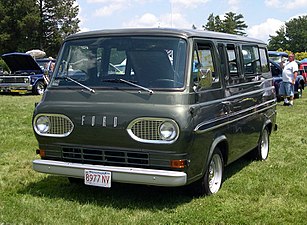

0 Komentar